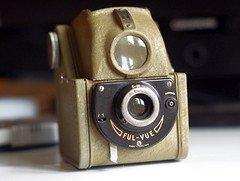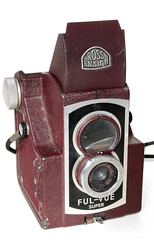Difference between revisions of "Ensign Ful-Vue"
(Image rights problem in this page.) |
(All image_rights now ok I think. Layout still ok?) |
||
| Line 6: | Line 6: | ||
||[http://www.flickr.com/photos/heritagefutures/3240310727/in/pool-camerawiki http://farm4.static.flickr.com/3267/3240310727_92f1728b40_m.jpg] | ||[http://www.flickr.com/photos/heritagefutures/3240310727/in/pool-camerawiki http://farm4.static.flickr.com/3267/3240310727_92f1728b40_m.jpg] | ||
|-align=center | |-align=center | ||
| − | ||The knob to unlock the camera | + | ||The knob to unlock the camera to open it. |
||The big finder. | ||The big finder. | ||
||The front. | ||The front. | ||
||The camera<br>(Barnet-Ensign design of 1946). | ||The camera<br>(Barnet-Ensign design of 1946). | ||
|-align=center | |-align=center | ||
| − | |colspan=4|<small>images by Dirk Spennemann</small> | + | |colspan=4|<small>images by Dirk Spennemann</small> {{with permission}} |
|} | |} | ||
{{Flickr_image | {{Flickr_image | ||
| − | |image_source= http://www.flickr.com/photos/graustark/532580529/ | + | |image_source= http://www.flickr.com/photos/graustark/532580529/in/pool-camerawiki/ |
|image= http://farm2.static.flickr.com/1158/532580529_4d13854810_m.jpg | |image= http://farm2.static.flickr.com/1158/532580529_4d13854810_m.jpg | ||
|image_align= right | |image_align= right | ||
|image_text= Early Ful-Vue: already with big finder | |image_text= Early Ful-Vue: already with big finder | ||
|image_by= graustark | |image_by= graustark | ||
| + | |image_rights=with permission | ||
}} | }} | ||
The earliest Ful-Vue version of 1939 was a typical [[box camera]] with back door, but already having the characteristic big [[viewfinder]]. Like other box cameras it had a back door and an inner camera part which could be taken out of the box to load the film. In 1946 the camera was redesigned, getting away from average box camera design. Then the inner part of the camera was fixed to the side panel with the film winding knob. The whole unit could be pulled out of the camera sidewards after unlocking it with the knob on the other side panel. | The earliest Ful-Vue version of 1939 was a typical [[box camera]] with back door, but already having the characteristic big [[viewfinder]]. Like other box cameras it had a back door and an inner camera part which could be taken out of the box to load the film. In 1946 the camera was redesigned, getting away from average box camera design. Then the inner part of the camera was fixed to the side panel with the film winding knob. The whole unit could be pulled out of the camera sidewards after unlocking it with the knob on the other side panel. | ||
| Line 27: | Line 28: | ||
|image_text= [[Ross-Ensign]] Ful-Vue Super | |image_text= [[Ross-Ensign]] Ful-Vue Super | ||
|image_by= uwekulick | |image_by= uwekulick | ||
| + | |image_rights=with permission | ||
}} | }} | ||
Shutter speed was 1/30 sec. in instant mode and B in time mode. Focusing was possible by pulling the lens out for close exposures. Pictures were 6×6cm on [[120 film]]. | Shutter speed was 1/30 sec. in instant mode and B in time mode. Focusing was possible by pulling the lens out for close exposures. Pictures were 6×6cm on [[120 film]]. | ||
| Line 41: | Line 43: | ||
|image_align= left | |image_align= left | ||
|image_text= Ful-Vue II color variant | |image_text= Ful-Vue II color variant | ||
| − | |image_by= Snapper 31 | + | |image_by= Snapper 31 |
|image_rights= with permission | |image_rights= with permission | ||
}} | }} | ||
| Line 48: | Line 50: | ||
|image=http://farm2.static.flickr.com/1327/5109066216_84a6aca3e2_m.jpg | |image=http://farm2.static.flickr.com/1327/5109066216_84a6aca3e2_m.jpg | ||
|image_align=left | |image_align=left | ||
| − | |image_text=Ful-Vue Super in Red | + | |image_text=Ful-Vue Super in Red |
| + | |image_by= AWCam | ||
| + | |image_rights=with permission | ||
}} | }} | ||
|} | |} | ||
| Line 56: | Line 60: | ||
|image= http://farm4.static.flickr.com/3095/3243116155_4629b3d0ff.jpg | |image= http://farm4.static.flickr.com/3095/3243116155_4629b3d0ff.jpg | ||
|image_align= right | |image_align= right | ||
| − | |image_text= Further disassembly of Barnet-Ensign Ful-Vue | + | |image_text= Further disassembly of Barnet-Ensign Ful-Vue |
| + | |image_by=fulvue | ||
| + | |image_rights=with permission | ||
}} | }} | ||
{|class="plainlinks floatright" | {|class="plainlinks floatright" | ||
| − | | colspan=2 | | + | | colspan=2 | Shutters: |
|- | |- | ||
|| [http://www.flickr.com/photos/31324280@N02/3243118807/in/pool-camerawiki/ http://farm4.static.flickr.com/3318/3243118807_414027b4f0_m.jpg] | || [http://www.flickr.com/photos/31324280@N02/3243118807/in/pool-camerawiki/ http://farm4.static.flickr.com/3318/3243118807_414027b4f0_m.jpg] | ||
| Line 66: | Line 72: | ||
|- | |- | ||
|| shutter of Barnet-Ensign Ful-Vue || shutter of Ful-Vue II | || shutter of Barnet-Ensign Ful-Vue || shutter of Ful-Vue II | ||
| + | |- | ||
| + | | colspan=2 align="center"|<small>images by fulvue</small> {{with permission}} | ||
|} | |} | ||
| + | {{Br}} | ||
{|class="plainlinks floatleft" | {|class="plainlinks floatleft" | ||
| Line 82: | Line 91: | ||
|- | |- | ||
|colspan=5| | |colspan=5| | ||
| − | || | + | ||Back with red window<br><small>image by Dirk Spennemann</small><br>{{with permission}} |
|}<br style="clear:right"/> | |}<br style="clear:right"/> | ||
The complete Ful-Vue series serves as a model for [[TTV]] cameras, cameras used for taking digital images through their amazingly big finders ([[TTV|through-the-viewfinder photography]]). | The complete Ful-Vue series serves as a model for [[TTV]] cameras, cameras used for taking digital images through their amazingly big finders ([[TTV|through-the-viewfinder photography]]). | ||
| + | |||
| + | |||
{|class=plainlinks | {|class=plainlinks | ||
| Line 95: | Line 106: | ||
||[http://www.flickr.com/photos/31324280@N02/3243118103/in/pool-camerawiki http://farm4.static.flickr.com/3088/3243118103_347f33130f_t.jpg] | ||[http://www.flickr.com/photos/31324280@N02/3243118103/in/pool-camerawiki http://farm4.static.flickr.com/3088/3243118103_347f33130f_t.jpg] | ||
|- | |- | ||
| − | |colspan=6|The finder housing with lenses and the retention springs which fix it over the mirror upon the camera body. | + | |colspan=6 align="center"|The finder housing with lenses and the retention springs which fix it over the mirror upon the camera body.<br><small>images by Dirk Spennemann and fulvue</small> {{with permission}} |
|}{{br}} | |}{{br}} | ||
| Line 102: | Line 113: | ||
|image= http://farm4.static.flickr.com/3319/3448361706_3e530d9b9d_m.jpg | |image= http://farm4.static.flickr.com/3319/3448361706_3e530d9b9d_m.jpg | ||
|image_align= right | |image_align= right | ||
| − | |image_text= Ful-Vue Super, distance scale<br /><small>image by fulvue {{with permission}} | + | |image_text= Ful-Vue Super, distance scale<br /><small>image by fulvue</small> {{with permission}} |
}} | }} | ||
{{Flickr_image | {{Flickr_image | ||
| Line 108: | Line 119: | ||
|image= http://farm2.static.flickr.com/1070/881565002_626c4ec60a_m.jpg | |image= http://farm2.static.flickr.com/1070/881565002_626c4ec60a_m.jpg | ||
|image_align= left | |image_align= left | ||
| − | |image_text= 1950s version, with plastic<br/>front and distance scale<br /><small>image by John Kratz {{ | + | |image_text= 1950s version, with plastic<br/>front and distance scale<br /><small>image by John Kratz</small> {{with permission}} |
}} | }} | ||
Revision as of 20:00, 10 April 2011
cit: "The Ful-Vue camera is really a very simple camera. It consists of a light-tight box. In front of the box there is a hole, over which the lens is fixed. Behind this hole is the shutter. There is a second lens in a second box above it. This produces a picture on the viewfinder on top of the camera. In the back of the box is another hole covered by a red window. This helps you in winding the film on, which you do by the knob at the side of the box near the top." [Marcel Natkin].

|

|

|

|
| The knob to unlock the camera to open it. | The big finder. | The front. | The camera (Barnet-Ensign design of 1946). |
| images by Dirk Spennemann (Image rights) | |||
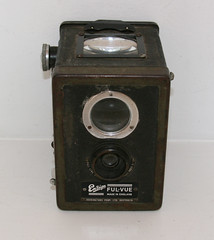
|
| Early Ful-Vue: already with big finder image by graustark (Image rights) |
The earliest Ful-Vue version of 1939 was a typical box camera with back door, but already having the characteristic big viewfinder. Like other box cameras it had a back door and an inner camera part which could be taken out of the box to load the film. In 1946 the camera was redesigned, getting away from average box camera design. Then the inner part of the camera was fixed to the side panel with the film winding knob. The whole unit could be pulled out of the camera sidewards after unlocking it with the knob on the other side panel.
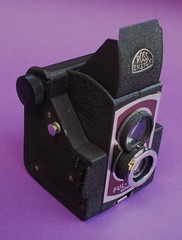
|
| Ross-Ensign Ful-Vue Super image by uwekulick (Image rights) |
Shutter speed was 1/30 sec. in instant mode and B in time mode. Focusing was possible by pulling the lens out for close exposures. Pictures were 6×6cm on 120 film.
In 1950 further improvements were made, the new flash synchronized shutter, the turnable lens barrel allowing three different distance settings instead of two, an all-plastic front panel, and an optional flashgun. The improved version was called Ful-Vue II. This was succeeded in 1954 by the Ross-Ensign Ful-vue Super, which had a flat front plate extending around both lenses, a cast alloy body (in place of the sheet steel) and a collapsible hood around the viewfinder. Its red window was closable. The film loading was eased another time by means of the removable back-and-bottom part which was held just by the clamp on the bottom. A more elegant flash unit was available, mountable without cable to a side panel of the camera.
Except for the Ful-Vue Super, which used 620 film the Ful-Vues use(d) type No. 120 rollfilm. An old Barnet-Ensign Ful-Vue may need some manipulation by simply bending the long metal strip that is part of the rollholder a little bit to achieve the necessary tension of the film. Using both rollfilm sizes in one Ful-Vue is not possible.
Most Ful-Vues were finished in dark grey crackle paint, but many other colours were made, in smaller quantities. In 1952 a special "silver" one was issued to celebrate the coronation of Queen Elizabeth II.
|
|
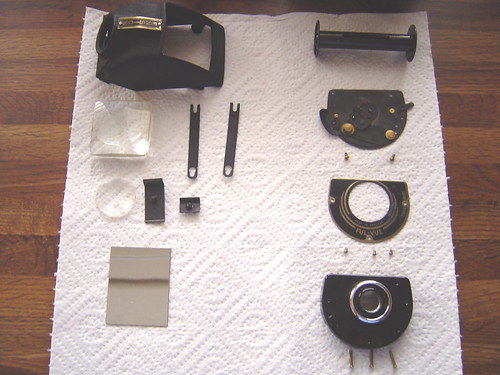
|
| Further disassembly of Barnet-Ensign Ful-Vue image by fulvue (Image rights) |
| Shutters: | |

|
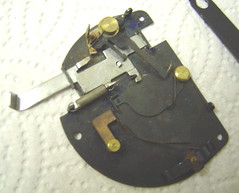
|
| shutter of Barnet-Ensign Ful-Vue | shutter of Ful-Vue II |
| images by fulvue (Image rights) | |
| Timeline | |||||
| The history of the Ful-Vue reflects the history of the Ensign companies: | 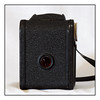
| ||||
| year | 1939 | 1946 | 1950 | 1954 | |
| name | Ful-Vue | Ful-Vue | Ful-Vue II | Ful-Vue Super | |
| maker | Ensign | Barnet Ensign | Barnet Ensign Ross | Ross-Ensign | |
| Back with red window image by Dirk Spennemann (Image rights) | |||||
The complete Ful-Vue series serves as a model for TTV cameras, cameras used for taking digital images through their amazingly big finders (through-the-viewfinder photography).

|

|

|

|

|

|
| The finder housing with lenses and the retention springs which fix it over the mirror upon the camera body. images by Dirk Spennemann and fulvue (Image rights) | |||||
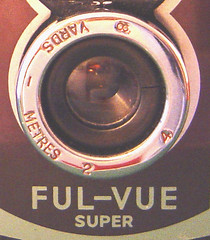
|
| Ful-Vue Super, distance scale image by fulvue (Image rights) |
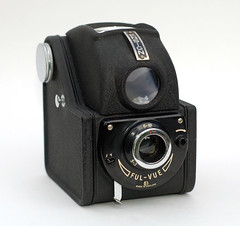
|
| 1950s version, with plastic front and distance scale image by John Kratz (Image rights) |
Links
- the Ful-Vue at www.ensign.demon [1]
- Full-Vue and User manual (for the early, box-form camera) at www.collection-appareils.com
- Flickr Group ful-vue with a lot of TTV images
- Ful-Vue at Living Image [2]
Literature
- Natkin, Marcel: Ful-Vue Guide. London and New York 1949 (2nd. edition 1951, 3rd ed. 1952., 4th ed. 1953)
